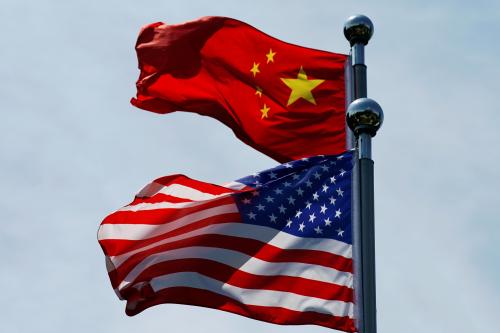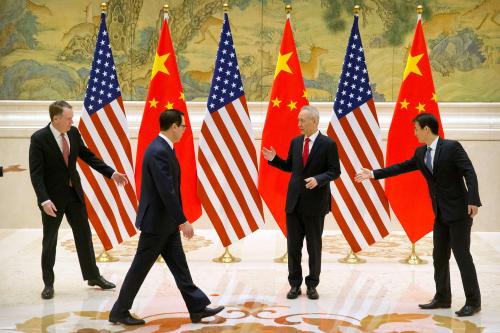This piece was cross-posted with the American Enterprise Institute.
As the dust settles on the U.S.-China Phase One deal signed on January 15, we want to give credit where credit is due, but also draw attention to what we see as the deal’s most troubling aspects. For a start, we applaud the Trump administration’s identification and bringing to a head the systemic challenges that China presents the U.S. and the world trading system—though we have fundamental disagreements on strategy and execution (as we wrote here). As for the deal itself, it attempts to address areas such as intellectual property protections and forced technology transfer in addition to nontariff barriers for agriculture and services exports, though the most fundamental market access barriers with China called out in the U.S. Trade Representative’s Section 301 report remain unaddressed. Our specific concern with the Phase One deal is China’s commitment to purchase $200 billion of U.S. products. This aspect of the deal is a complete break from past U.S. trade deals, contrary to free market values, gives China leverage over the U.S., and creates strategic costs for the U.S. by undermining U.S. global economic leadership.
Under the Phase One deal, China has agreed to purchase $200 billion worth of U.S. goods and services in 2020 and 2021, on top of the amounts imported in 2017. This purchasing commitment does not cover all U.S. exports to China, but applies to select agriculture, energy, manufacturing, and services imports. To put this into context, in 2017, the U.S. exported approximately $170 billion to China, so the deal would require China to essentially more than double its purchases of U.S. products in the next two years, an outcome that is unrealistic at best.
Viewed as a simple purchase contract between two private entities, the deal may make some sense. However, understood correctly as a trade deal between two sovereign nations, the purchase commitments are not merely out of place—they create two specific and related problems. One, this deal gives China leverage over the United States that it did not previously possess. Two, these commitments undermine market forces and the rules-based trading system, with both direct and strategic costs for the U.S.
First, while the U.S. may believe it has created leverage over China through this managed trade relationship where China is depending on U.S. exports, it’s actually the opposite. Because these purchases are not market-based (if they were, the commitments would have been unnecessary), they actually create stronger U.S. dependencies on China. Because of its state-led and controlled economy, China could gin up demand to try and meet these commitments, but the spigot could likewise be turned off at any point and for any reason. Many U.S. exports are fungible and depend on long-term certainty. We have already seen the costs to U.S. agriculture from targeted Chinese tariffs during the U.S.-China trade war, for instance. Consider how much damage could be done where the dependency is to the tune of $370 billion. In addition, who is to say that once the purchase commitment period is over, China does not use this heightened dependence of U.S. exporters on the Chinese market to demand U.S. concessions or push back on U.S. demands for further reform. Add in the political costs to the U.S. administration of China not fulfilling these purchase agreements, and it becomes clear how much leverage these purchase commitments give President Xi over President Trump.
Administration officials claim that China’s purchasing commitments are enforceable through the deal’s bilateral dispute settlement mechanism, which has been touted as a legal process but is a political process whereby, in reality, tariffs can be imposed unilaterally. However, despite Trump’s willingness to use tariffs against China to date, the dynamics post-deal have likely shifted such that the U.S. threat of additional tariffs should China not fulfill these commitments increasingly lacks credibility: Further tariffs create additional economic and political costs for Trump in an election year, and would reveal how Trump’s strategy with China has failed.
Second, the purchase commitments undermine U.S. global economic leadership and risk the U.S. ceding the high ground on the preeminence of its economic model. In fact, they betray long-standing core principles espoused by the U.S. such as free markets and the rule of law, and, in the process, affirm and elevate the Chinese state-led and controlled dirigiste model of economic growth and trade. They negatively affect the terms of trade for key U.S. allies such as Australia, the EU, Korea, and Japan, who are also significant exporters of agriculture, energy, and manufactured goods to China. Lastly, while the unilateral imposition of tariffs by the U.S. and China have been WTO inconsistent, the trade deal itself and the purchase commitments raise additional questions regarding their WTO consistency, further undermining the global rules-based trading system.
Previous U.S. trade agreements have incrementally built on their predecessors and were used by successive administrations as templates for the next country eager to enter into a deal with the U.S. This is not such a trade deal. As we look to potential “Phase Two” negotiations with China or any other trade agreement, the purchase commitments create significant direct and systemic costs for the U.S. that we hope we never see again in any future trade deal.
The Brookings Institution is committed to quality, independence, and impact.
We are supported by a diverse array of funders. In line with our values and policies, each Brookings publication represents the sole views of its author(s).








Commentary
Why the purchase commitments in the US-China trade deal should not be replicated, ever
February 4, 2020